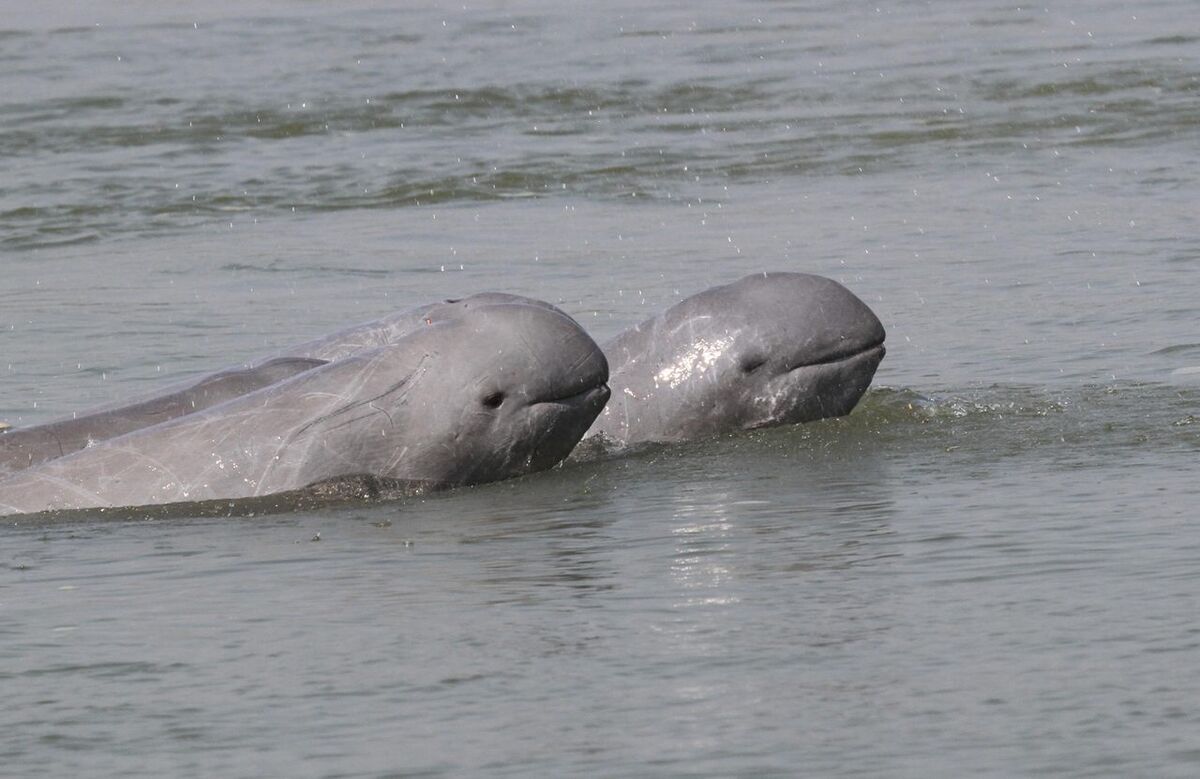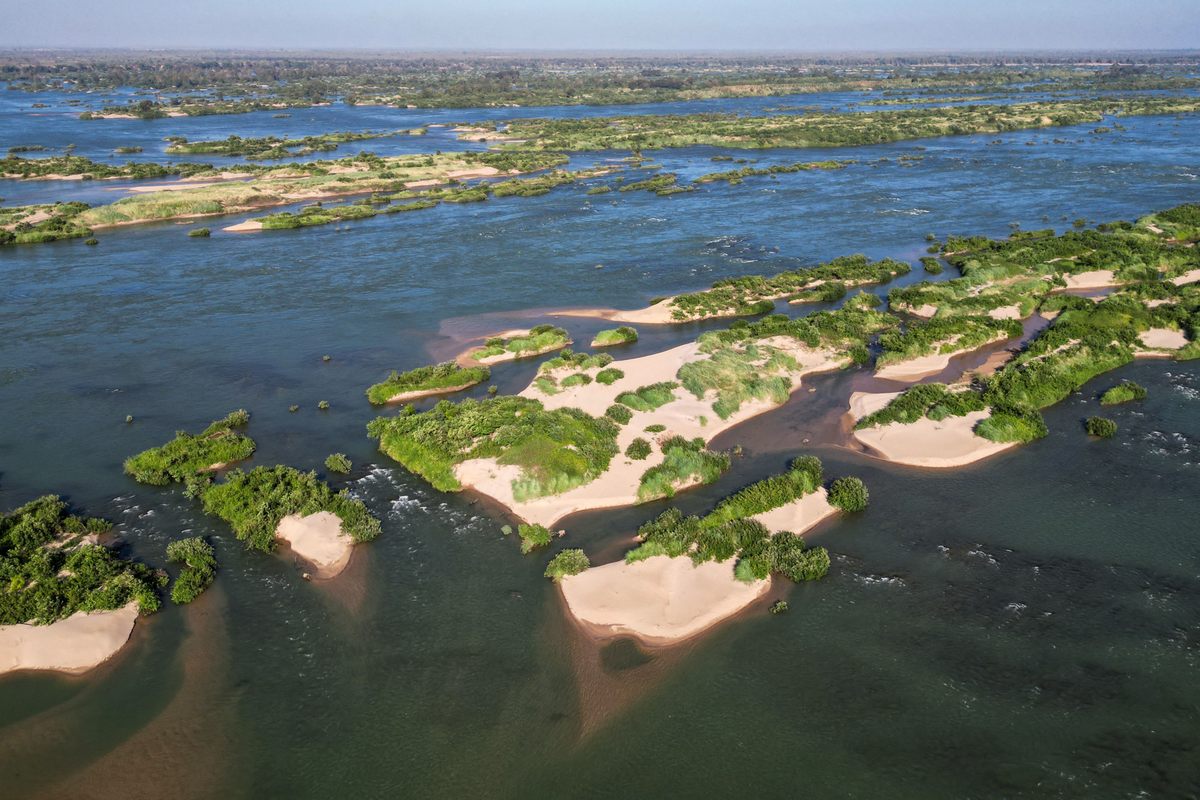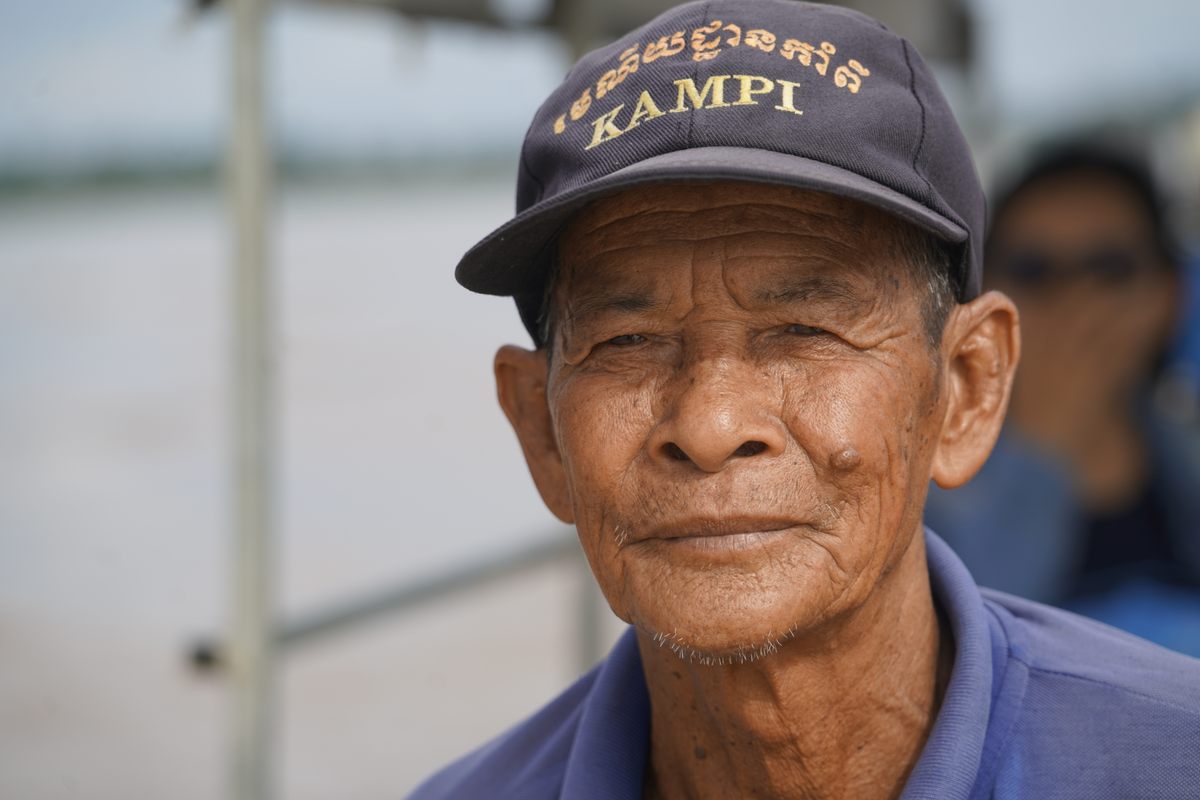Irrawaddy Dolphins Get Help from an Ancient Cambodian Folktale by Stefan Lovgren
Nov 28, 2023 16:57:27 #
https://www.atlasobscura.com/articles/irrawaddy-dolphins-cambodia-mekong?
In the Mekong River, protecting the revered but critically endangered mammals is also a way for locals to reclaim their culture.
During the monsoon season in Cambodia, torrential downpours slash their way across lush landscapes. But on this September afternoon, the sky is clear as we head out on the Mekong River, full with murky water from the recent rains. Our guide, 75-year-old Sok Chea, is taking us to see the area’s famous but rare Irrawaddy dolphins—today, only about 100 individuals remain in the 2,700-mile-long river. After finding a group of them along the opposite river bank, Chea begins to tell the origin story of the dolphins. It is a folktale familiar to most Cambodian visitors.
As the legend goes, there was once a girl whose parents married her away to what they thought was a wealthy deity disguised as a python. But the python was just a python, and proceeded to eat the poor girl. She was rescued after the snake’s stomach was cut open but, covered in stinky slime, was too embarrassed to go on living—she tried to drown herself in the river, but instead turned into a beautiful dolphin, an animal no one knew existed before. “People like the story, because it shows dolphins are like humans,” says Chea, who grew up on the river and has guided tourists to see the dolphins for the past 15 years.
In a country rich in folklore that celebrates the connections between animals and humans, the dolphins have become a national symbol of pride thanks, in large part, to the legend. It’s a reason why the critically endangered population of dolphins has even survived. “The folktale sends a conservation message that helps protect the dolphins,” says Somany Phay, a senior conservation officer with the World Wildlife Fund and the Cambodian Fisheries Administration.
There are six species of river dolphins in the world, and they are among the most endangered creatures on the planet. The Irrawaddy dolphins, which, with their bulging foreheads, resemble small beluga whales, are found in only three tiny freshwater populations: in the Irrawaddy River in Myanmar; the Mahakam River in Indonesia; and in this short, bio-rich stretch of the Mekong River near Kampi in northern Cambodia. This section is pocketed by deep pools that may serve as a refuge for the enigmatic dolphins as well as megafish such as the giant freshwater stingray.
Chea moved to Kampi when he was 15 years old. He remembers seeing large schools of dolphins in the river then, followed by fishermen in row boats who relied on the animals to lead them to the fish.
Everything changed when Cambodia succumbed to political conflict and war, leading to the 1975 takeover by the genocidal Khmer Rouge regime. Chea, his family, and countless others were relocated and forced to farm rice, part of regime leader Pol Pot’s obsession with building an agrarian socialist utopia.
Under the Khmer Rouge, the telling of stories was forbidden and often punished by death. Dolphins were killed indiscriminately for their oil. Records kept by the regime show it also sold parts of other animals—including bears, elephants, and tigers—in large quantities to China in exchange for agricultural products and military materials. Chea, accused of being a spy for Vietnamese enemy forces, was shot twice, in the heel and thigh, but survived. Others were not so lucky. Mass executions, coupled with malnutrition and poor medical care, killed up to two million Cambodians.
After the fall of the Khmer Rouge, Chea returned to Kampi and found there were still a lot of dolphins left. But, over time, fishing on the Mekong expanded. Newer gill nets sometimes snared and drowned the dolphins. Dam construction and other human activity posed additional threats to the Mekong dolphins—the last member of a small group near the border with Laos, the only other population living in the river, died in 2022. In 2015, a census of the dolphin population near Kampi counted only 80 individuals remaining.
By then, local law enforcement had cracked down on unsustainable fishing practices. The government also promoted the dolphins as a flagship species and tourist attraction—a message that aligned with the fishers who remembered the old folktale, and played a role in the modest population rebound to about 100 individuals today.
“Fishers don’t want to kill dolphins, it is considered bad luck,” says Chea Seila, program manager for the USAID-supported Wonders of the Mekong project. The program encourages fishers to release critically endangered fish, such as the Mekong giant catfish and giant barb, which are also revered among Cambodians.
In fact, many animals are held in high esteem among Cambodians, thanks to folktales that have endured. Toads are admired because one story suggests they can command the rain. Sopor Kaley, a sacred mountain located not far from Kampi, is believed to contain the remains of a powerful and magical crocodile that was killed by an even larger crocodile with a head seven “hats” long (in Cambodian tradition, one hat is the distance from fingertip to elbow).
These folktales do more than instill a respect for nature and wildlife, says Youk Chhang, executive director of the Documentation Center of Cambodia in Phnom Penh, which preserves records of the horrific Khmer Rouge era. Chhang says traditional stories, banned under Pol Pot, also encourage freedom of thinking and imagination. “These stories were buried by war and genocide for decades,” says Chhang. “Sharing them is a way of regaining what we have lost.”
“These stories were buried by war and genocide. Sharing them is a way of regaining what we have lost.”
Chhang, a survivor of the genocide more than four decades ago, remembers reading the dolphin story as a child in comic books that were sold outside his elementary school. Whether it’s in a comic book or on social media, he believes the old folktales will always have a new audience: “[Young people] are thirsty for cultural connections and stories that can help them feel proud as Cambodians.”
Back on the Mekong River, the sun dips toward the horizon and Chea tells us it’s time to return to Kampi. The small outboard motor sputters to life and our boat glides eastward, leaving behind the dolphins who, like Chea and the folktale that connects them, are a symbol of survival and resilience.
In the Mekong River, protecting the revered but critically endangered mammals is also a way for locals to reclaim their culture.
During the monsoon season in Cambodia, torrential downpours slash their way across lush landscapes. But on this September afternoon, the sky is clear as we head out on the Mekong River, full with murky water from the recent rains. Our guide, 75-year-old Sok Chea, is taking us to see the area’s famous but rare Irrawaddy dolphins—today, only about 100 individuals remain in the 2,700-mile-long river. After finding a group of them along the opposite river bank, Chea begins to tell the origin story of the dolphins. It is a folktale familiar to most Cambodian visitors.
As the legend goes, there was once a girl whose parents married her away to what they thought was a wealthy deity disguised as a python. But the python was just a python, and proceeded to eat the poor girl. She was rescued after the snake’s stomach was cut open but, covered in stinky slime, was too embarrassed to go on living—she tried to drown herself in the river, but instead turned into a beautiful dolphin, an animal no one knew existed before. “People like the story, because it shows dolphins are like humans,” says Chea, who grew up on the river and has guided tourists to see the dolphins for the past 15 years.
In a country rich in folklore that celebrates the connections between animals and humans, the dolphins have become a national symbol of pride thanks, in large part, to the legend. It’s a reason why the critically endangered population of dolphins has even survived. “The folktale sends a conservation message that helps protect the dolphins,” says Somany Phay, a senior conservation officer with the World Wildlife Fund and the Cambodian Fisheries Administration.
There are six species of river dolphins in the world, and they are among the most endangered creatures on the planet. The Irrawaddy dolphins, which, with their bulging foreheads, resemble small beluga whales, are found in only three tiny freshwater populations: in the Irrawaddy River in Myanmar; the Mahakam River in Indonesia; and in this short, bio-rich stretch of the Mekong River near Kampi in northern Cambodia. This section is pocketed by deep pools that may serve as a refuge for the enigmatic dolphins as well as megafish such as the giant freshwater stingray.
Chea moved to Kampi when he was 15 years old. He remembers seeing large schools of dolphins in the river then, followed by fishermen in row boats who relied on the animals to lead them to the fish.
Everything changed when Cambodia succumbed to political conflict and war, leading to the 1975 takeover by the genocidal Khmer Rouge regime. Chea, his family, and countless others were relocated and forced to farm rice, part of regime leader Pol Pot’s obsession with building an agrarian socialist utopia.
Under the Khmer Rouge, the telling of stories was forbidden and often punished by death. Dolphins were killed indiscriminately for their oil. Records kept by the regime show it also sold parts of other animals—including bears, elephants, and tigers—in large quantities to China in exchange for agricultural products and military materials. Chea, accused of being a spy for Vietnamese enemy forces, was shot twice, in the heel and thigh, but survived. Others were not so lucky. Mass executions, coupled with malnutrition and poor medical care, killed up to two million Cambodians.
After the fall of the Khmer Rouge, Chea returned to Kampi and found there were still a lot of dolphins left. But, over time, fishing on the Mekong expanded. Newer gill nets sometimes snared and drowned the dolphins. Dam construction and other human activity posed additional threats to the Mekong dolphins—the last member of a small group near the border with Laos, the only other population living in the river, died in 2022. In 2015, a census of the dolphin population near Kampi counted only 80 individuals remaining.
By then, local law enforcement had cracked down on unsustainable fishing practices. The government also promoted the dolphins as a flagship species and tourist attraction—a message that aligned with the fishers who remembered the old folktale, and played a role in the modest population rebound to about 100 individuals today.
“Fishers don’t want to kill dolphins, it is considered bad luck,” says Chea Seila, program manager for the USAID-supported Wonders of the Mekong project. The program encourages fishers to release critically endangered fish, such as the Mekong giant catfish and giant barb, which are also revered among Cambodians.
In fact, many animals are held in high esteem among Cambodians, thanks to folktales that have endured. Toads are admired because one story suggests they can command the rain. Sopor Kaley, a sacred mountain located not far from Kampi, is believed to contain the remains of a powerful and magical crocodile that was killed by an even larger crocodile with a head seven “hats” long (in Cambodian tradition, one hat is the distance from fingertip to elbow).
These folktales do more than instill a respect for nature and wildlife, says Youk Chhang, executive director of the Documentation Center of Cambodia in Phnom Penh, which preserves records of the horrific Khmer Rouge era. Chhang says traditional stories, banned under Pol Pot, also encourage freedom of thinking and imagination. “These stories were buried by war and genocide for decades,” says Chhang. “Sharing them is a way of regaining what we have lost.”
“These stories were buried by war and genocide. Sharing them is a way of regaining what we have lost.”
Chhang, a survivor of the genocide more than four decades ago, remembers reading the dolphin story as a child in comic books that were sold outside his elementary school. Whether it’s in a comic book or on social media, he believes the old folktales will always have a new audience: “[Young people] are thirsty for cultural connections and stories that can help them feel proud as Cambodians.”
Back on the Mekong River, the sun dips toward the horizon and Chea tells us it’s time to return to Kampi. The small outboard motor sputters to life and our boat glides eastward, leaving behind the dolphins who, like Chea and the folktale that connects them, are a symbol of survival and resilience.
Irrawaddy dolphins cruise the Mekong River near the Cambodian village of Kampi, which has become a hub for tourists eager to spot the critically endangered animals. Xinhua/WWF-Cambodia via Getty Images

Cambodia’s last population of Irrawaddy dolphins live in this bio-rich stretch of the Mekong, where deep pools may offer protected areas for the mammals and fish such as the giant freshwater stingray. SARAH LAI/AFP via Getty Images

Sok Chea returned to Kampi, where he lived as a young man, after the fall of the genocidal Khmer Rouge regime, which had displaced him and millions of other Cambodians. Stefan Lovgren

Nov 29, 2023 05:49:52 #
bcheary wrote:
Interesting ! When we were in India's Odisha region, Lake Chilika there had Irrawady Dolphins.I found this youtube video:
https://www.youtube.com/watch?v=rEJWkRx4t8M
Nov 29, 2023 10:56:23 #
venkatesh_eng wrote:
Interesting ! When we were in India's Odisha region, Lake Chilika there had Irrawady Dolphins.I found this youtube video:
https://www.youtube.com/watch?v=rEJWkRx4t8M
https://www.youtube.com/watch?v=rEJWkRx4t8M
Cool. Thanks.



If you want to reply, then register here. Registration is free and your account is created instantly, so you can post right away.
